Study Guide Zoology
1/197
Earn XP
Description and Tags
Exam 2
Name | Mastery | Learn | Test | Matching | Spaced |
|---|
No study sessions yet.
198 Terms
What is a Gene Pool?
Each population shares a group of genes with some alleles more commonly present than others. Leading to different phenotypes that contribute to genetic diversity within the population, influencing traits and adaptation. The best phenotypes survive and reproduce more, offspring inherits genotype rather than phenotypes.
Evolutionary mechanisms
are natural processes such as mutation, natural selection, gene flow, non-random mating, and genetic drift that drive changes in allele frequencies within a gene pool over time.
Hardy Weinburg Equilibrium
A mathematical model of allele frequencies. It describes the genes of a population that remains constant from one generation to the next in the absence of evolutionary mechanisms.
Speciation
The process by which new and distinct species evolve from an ancestral species due to factors such as geographic isolation, genetic divergence, and reproductive isolation.
Reproductive Isolation
Any heritable feature of body form, functioning, or behavior that prevents interbreeding between one or more genetically divergent populations a byproduct of genetic change.
Genetic Divergence
The gene pools of genetically separate populations accumulate distinct differences, from mutation, natural selection, and genetic drift and are modifying each one independently of the others.
Prezygotic mechanisms
Prevents the formation of zygotes
Postzygotic mechanism
Reduced fitness or prevents hybrids
Species Concept: Biological
A species consists of one or more population of individuals that can interbreed under natural conditions and produce fertile offspring and that are reproductively isolated from other populations.
Species Concept: Phylogenetic
A species is a group of populations that have evolved independently of other groups of populations. They share one or more synapomorphies.
Types of Speciation: Allopatric Speciation
Speciation that occurs when populations are geographically separated, leading to reproductive isolation. There is physical separation between populations and is the main route for speciation.
Speciation Definition
The process through which new species arise from existing species, often involving mechanisms like allopatric or sympatric processes.
Types of Speciation: Sympatric Speciation
Speciation that occurs when populations evolve while inhabiting the same geographical area, often due to behavioral differences or polyploidy. It leads to reproductive isolation without physical separation. New species forms within the home range of the parent population, may be a physical barrier not seen by humans.
Types of Speciation: Parapatric Speciation
Speciation that occurs when populations are partially geographically separated but still have contact along a border. This can result in limited gene flow and subsequent reproductive isolation. Different environmental condition that either parental species habitat, could be secondary contact or formation of third species.
Rates of Evolutionary Change: Phyletic Gradualism
A model of evolution that theorizes that most speciation occurs slowly, uniformly, and gradually. Species transform steadily overtime, leading to the emergence of new species.
Rates of Evolutionary Change: Punctuated Equilibrium
A theory that suggests that evolution occurs through short bursts of intense speciation, followed by long periods of stability. Once a species occurs in the fossil record, it remains unchanged for most of its geological history with changed happening in rapid bursts.
Mosaic Evolution
Evolution works on individual traits not the whole organism at the same time.
Homology
Similarity of the structure, physiology, or development of various species of other organism as a result of their shared evolutionary parent. Same developmental patterns in different animals.
Molecular Homology
Genetic code, nucleotide triplets, codons, amino acids.
Processed pseudogenes
Nonfunctional copies of normal genes which are reversed, transcribed, and reinserted.
Genotype
The genes present
Phenotype
the physical and visible result of the genes
Allele
alternate forms of a given gene
Allele frequency
percentage of each allele in the population
Genotype and Phenotype frequency
Percentage of each genotype or phenotype in the population
What is the Hardy Weinburg Equilibrium and why is it important?
It is a mathematical model developed independently by GH Hardy and W. Weinburg in 1908. It is a null model because it is a negative control that aims to show that evolution is not occurring.
Microevolution
is the small-scale change in allele frequencies brought by mutation, natural selection, gene flow, non-random mating, and genetic drift.
Homozygous definition
Two of the same alleles together at one loci
Heterozygous definition
Two different alleles together at the same loci
Population definition
A group of interbreeding individuals and their offspring
Dominant Allele definition
The allele that is expressed if at least one copy is present
Recessive Allele definition
The allele that is expressed only if 2 copies are present
Hardy Weinburg Rules
-No Mutation, No natural selection, Population is infinitely big, no genetic drift, population is isolated from others of the same species, no gene flow, all mating is random
Life Cycle of a population
Adults make gametes, gametes combine to make zygotes, which develop into juveniles, then they grow up to be the next generation of adults.
Adults are diploids meaning…
Adults carry 2 alleles at a given locus (A and a), gametes contain one allele at each locus (A OR a)
Genotype frequency Equation
p²+2pq+q²=1
Allele Frequency Equation
p+q=1
Ecology
The study of the interactions of organisms with each other and with the physical environment.
Levels of Organization of populations
Ecosystem: Communities in a large area, together with their physical environment
Community: All of the organisms in a particular area
Population: Organisms of the SAME species that occur together
Individual: A single organism
Ecological Factors: Abiotic factors
Non-living things that can be applied to aspects of an organisms environment. (sun, space, food, water)
Ecological Factors: Biotic Factors
Living things; usually applied to the biological aspects of an organisms environment. (predators, competitors, mutualistic partners)
Community Structure definition
The number and types of species present
Species Abundance
The proportion of a given species present.
Species Diversity
The number of species present and their relative abundance
Resources
Any substance or object that organisms require and need for survival, growth, and reproduction. Resources can be consumed by one organism and as a result, become unavailable to another organism.
Resources Partitioning (allocation of them)
Survival, Growth, Reproduction
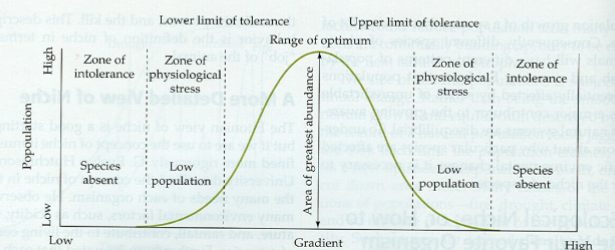
Physiological Tolerance
The set of physical conditions under which an organism still remains alive. (energy budgets, temperature budgets, water budgets)
Homeostasis (Homeo=Same) (Stasis=Condition
Maintaining a constant internal environment
Regulators
Maintain internal conditions significantly different than the environment, often requires input of energy
Conformers
Allows internal conditions to follow the environment, usually doesn’t require an input of energy
The Niche
A suit of physical and chemical factors that limit where an organism can live
Fundamental Niche
where an organism is capable of living
Realized Niche
where the organism is actually found
Population Distribution
How the population is spread out within its habitat (clumped, uniform, random)
Population size
Total # of individuals in the population
Population density
Number of individuals per unit area in the population
Competition
The interaction that occurs when organisms of the same or different species use the same resources that is in short supply or when they harm one another in seeking that common resource
Intraspecific competition
Competition within a species
Interspecific competition
Competition between different species
Result of competition
Reduces reproductive rate and increases death rates
Exploitation
An interaction between species that enhances the fitness of the exploiting individual (the predator, pathogen) while the reducing the fitness of the exploited individual (the prey, host)
Types of exploitation
Predators: A heterotroph that eats another heterotroph
Herbivore: A heterotroph that eats an autotroph
Parasites: A heterotroph that eats another organism very slowly
Mutualism
Two species that live in or on one another in an intimate relationship where both parties gain from the relationship, resulting in increased growth & reproduction, decreases death rates.
Types of Mutualism: Facultative Mutualism
Organisms that can live without their mutualistic partner (Cleaner wrasse and fish)
Types of Mutualism: Obligate Mutualism
Organisms that cannot live without their mutualistic partner (coral and dinoflagellates)
Populations size increase due to…
immigration and birth
Populations size decrease due to…
emigration and death
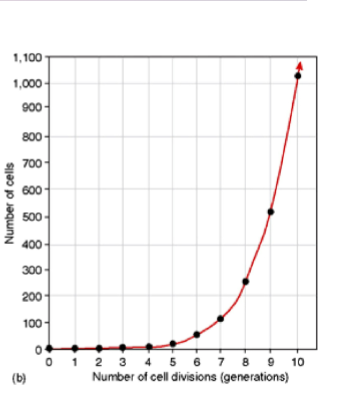
Population Growth Rates
Lag Phase-period of time where population remains small and constant. Occurs because reproduction isn’t instant
Exponential Growth-Rapid increase in population size without constraints, (such as no competition and resource limitation) which results in a J shaped curve where the growth rate remains constant
S shaped Curve- represents logistic Growth
Deceleration Phase: Rate of growth slows density dependent forces
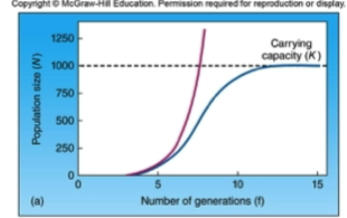
Biotic Potential
The maximum number of offspring that can be produced with unlimited resources
Limiting resources are…
any resource in short supply
Factors that Control population Growth Rate: Density Dependent Control
Tend to be biotic factors (predators, parasites, pathogens) that reduce birth rates or increase death rates
Factors that Control population Growth Rate: Density Independent Control
Tend to be abiotic factors (bad weather, rockslide, natural disasters, wildfires) that prevents births or cases deaths no matter the density of the population.
Carry Capacity=K
The maximum number of individuals in a population that a given environment can sustain indefinitely. “K” includes limited resources, density dependent controls, competition. It can also very if you can change the resource base
Age Specific Patterns
Gives you more information on where your population size is going. (chances of dying, chances of giving birth)

Survivorship Curves
Type 1: low death rates until old age (humans in developed countries and large mammals)
Type 2: Constant death rate throughout life (songbirds, small mammals)
Type 3: High mortality early in life (invertebrates)
Age Specific Survival
The probability of being alive at any given stage of life
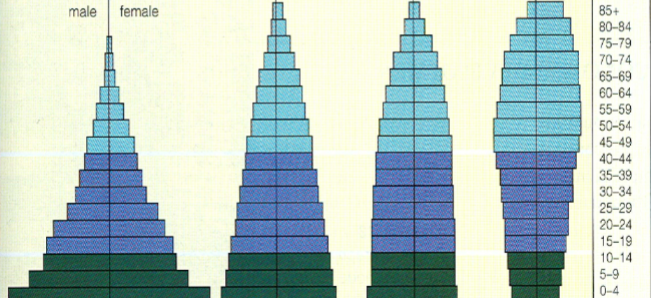
Age Structure
Pre-reproductive: Green
Reproductive: Dark Blue
Post-reproductive: Light Blue
Rapid Growth: Big bottom small top (Saudi Arabia, India)
Slow Growth: Steady increase (US, Canada)
Zero Growth: Fat bottom and Waist (Denmark, Italy)
Negative Growth: Big top small bottom (Germany, Hungary)
Life History Patterns: Opportunistic (R)
They have short life spans, are small, fast to mature, have many offspring, little care for offspring
Life History Patterns: Equilibrium (K)
They are large individuals who have a long life span, Slow to mature, have few offspring, and offer parental care.
Species Richness definition
Number of different species present in a specific area or ecosystem.
Species Abundance definition
Number of individuals of a particular species within an area or ecosystem
Guilds defintion
Group of organisms that make their living in a similar way (filter feeders, herbivores, deposit feeders)
Functional groups
Primary producers, secondary consumers, decomposers.
Competitive Exclusion Principle
Two species that use exactly the same resources in exactly the same way cannot coexist in the same place forever.
Ways around the Competitive Exclusion Principle
Resource Partitioning: Subdividing a resource in the way it is used (ex. Each species of bird feeds at a different point in the tree)
Resource Specialization: Using only a very specific resource
No Niche Overlap
Disturbance Definition
Anything that disrupts the current community structure
Ecological Succession
The gradual change in species composition in a given area. Succession doesn’t follow a predictable path
Keystone Species
A species that has a greater effect on the stability of the community than its number would imply. Loss of this species would cause a very large change in the community. (Function Keystone: Pollinators and Decomposers, Predator: A species that feeds on preferentially on the competitive dominant and control their population)
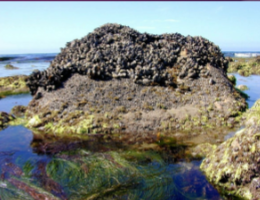
Which animal is the keystone species?
Pisaster (sea star) is the keystone species while Mytilus (California mussel) is the competitive dominant.
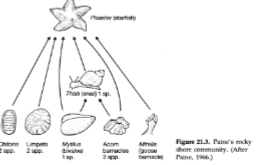
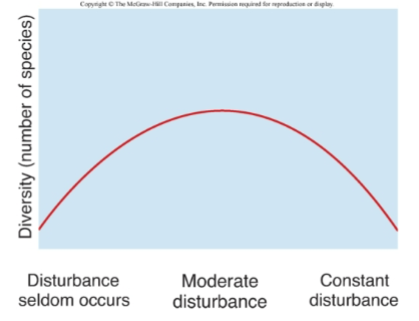
Intermediate Disturbance Hypothesis
Disturbances intermediate in size and frequency leads to the highest species diversity.
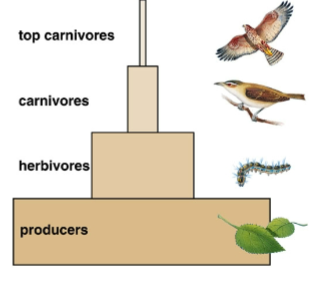
Food Web Diagram
Summarizes the feeding relation in a community
Trophic level: where the organism feeds within the food web
Level 4: Top carnivores (Apex Predators)
Level 3: Secondary Consumers (Carnivores)
Level 2: Primary Consumers (Herbivores)
Level 1: Primary Producers (plants)
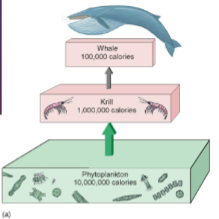
Trophic Interactions Ecological Pyramids
The amount of usable energy declines at each level as you move up the web. 1-10% energy transfer from one tropic level to the next. Biomass declines as you move up the web. Body size of organisms increases while the number of individuals decrease as you move up the web.
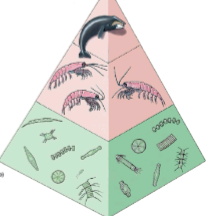
Importance of Community Stability
Ecological Communities are important because of their unique combination of native biodiversity, distinctive landscapes/seascape values, vital habitat qualities and for the ecosystem services they provide.
4 Types of Ecosystem Services
Provisioning: Production of food and water
Regulating: Control of Climate and disease
Cultural: Spiritual and Recreational benefits
Supporting Services: Nutrients cycles and oxygen production
Physically Diverse Habitats
The more physically diverse the more species can live there, more sub-plants, topography, and sediment types.
Factor of stability in a changing environment: Inertia/ Resistance
The ability to keep from being disturbed and altered
Factor of Stability in a Changing Environment: Constancy
The ability to keep population sizes within environmental limits
Factor of Stability in a Changing Environment: Resilience
The ability to repair damage after a disturbance or change.
Homeostasis Lecture 10 Intro
All living things must bring in energy and resources to maintain life
There is a finite amount of energy and resources in the universe
Conditions within living systems are very different than in the environment in general
Homeostasis LONG Definition
Evolutionary change produces systems that maintain homeostasis within organisms and regulate the distribution and allocation of resources leading to a better ability to capture and process resources that leads to more offspring being produced evolution makes reproduction more successful. All Biology boils down to sex and food.